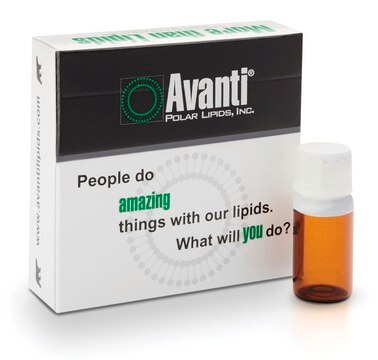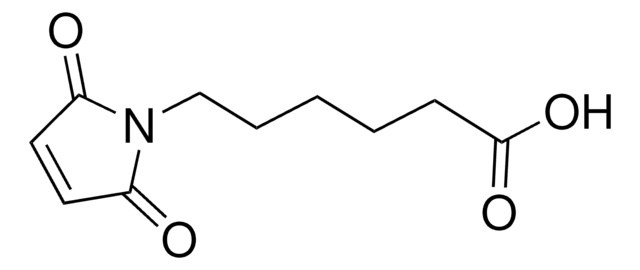870016P
Avanti
23:2 Diyne PC [DC(8,9)PC]
Avanti Polar Lipids 870016P, powder
Synonym(e):
1,2-bis(10,12-tricosadiynoyl)-sn-glycero-3-phosphocholine
About This Item
Empfohlene Produkte
Form
powder
Verpackung
pkg of 1 × 1 g (870016P-1g)
pkg of 1 × 200 mg (870016P-200mg)
pkg of 1 × 25 mg (870016P-25mg)
pkg of 1 × 500 mg (870016P-500mg)
Hersteller/Markenname
Avanti Polar Lipids 870016P
Versandbedingung
dry ice
Lagertemp.
−20°C
SMILES String
[O-]P(OCC[N+](C)(C)C)(OC[C@]([H])(OC(CCCCCCCCC#CC#CCCCCCCCCCC)=O)COC(CCCCCCCCC#CC#CCCCCCCCCCC)=O)=O
InChI
1S/C54H92NO8P/c1-6-8-10-12-14-16-18-20-22-24-26-28-30-32-34-36-38-40-42-44-46-53(56)60-50-52(51-62-64(58,59)61-49-48-55(3,4)5)63-54(57)47-45-43-41-39-37-35-33-31-29-27-25-23-21-19-17-15-13-11-9-7-2/h52H,6-23,32-51H2,1-5H3/t52-/m1/s1
InChIKey
IDBJTPGHAMAEMV-OIVUAWODSA-N
Verwandte Kategorien
Allgemeine Beschreibung
Anwendung
Verpackung
Lagerklassenschlüssel
11 - Combustible Solids
Analysenzertifikate (COA)
Suchen Sie nach Analysenzertifikate (COA), indem Sie die Lot-/Chargennummer des Produkts eingeben. Lot- und Chargennummern sind auf dem Produktetikett hinter den Wörtern ‘Lot’ oder ‘Batch’ (Lot oder Charge) zu finden.
Besitzen Sie dieses Produkt bereits?
In der Dokumentenbibliothek finden Sie die Dokumentation zu den Produkten, die Sie kürzlich erworben haben.
Unser Team von Wissenschaftlern verfügt über Erfahrung in allen Forschungsbereichen einschließlich Life Science, Materialwissenschaften, chemischer Synthese, Chromatographie, Analytik und vielen mehr..
Setzen Sie sich mit dem technischen Dienst in Verbindung.
![23:2 Diyne PE [DC(8,9)PE] 1,2-bis(10,12-tricosadiynoyl)-sn-glycero-3-phosphoethanolamine, powder](/deepweb/assets/sigmaaldrich/product/images/228/422/4e95f75c-14fa-4117-a383-2eff73fa927f/640/4e95f75c-14fa-4117-a383-2eff73fa927f.jpg)







